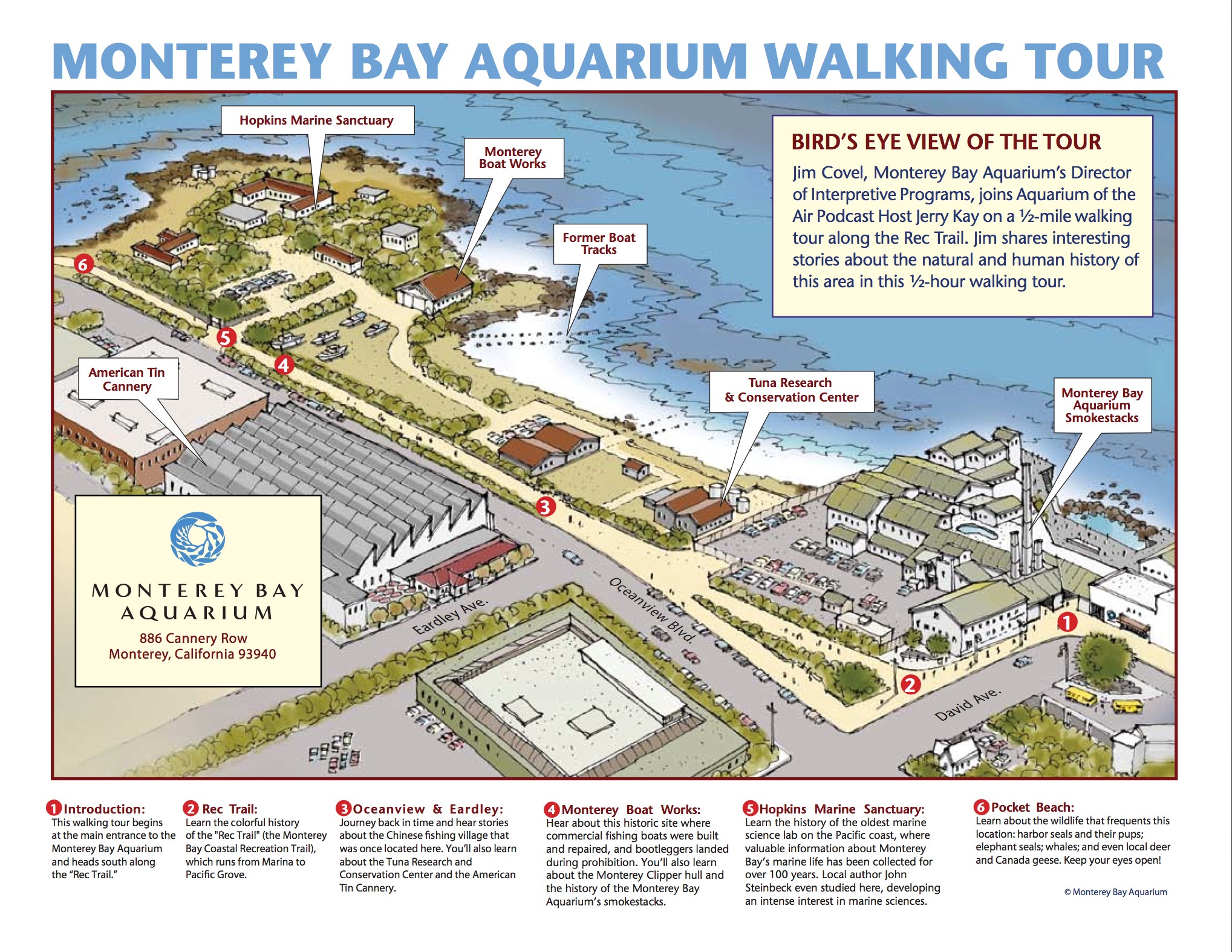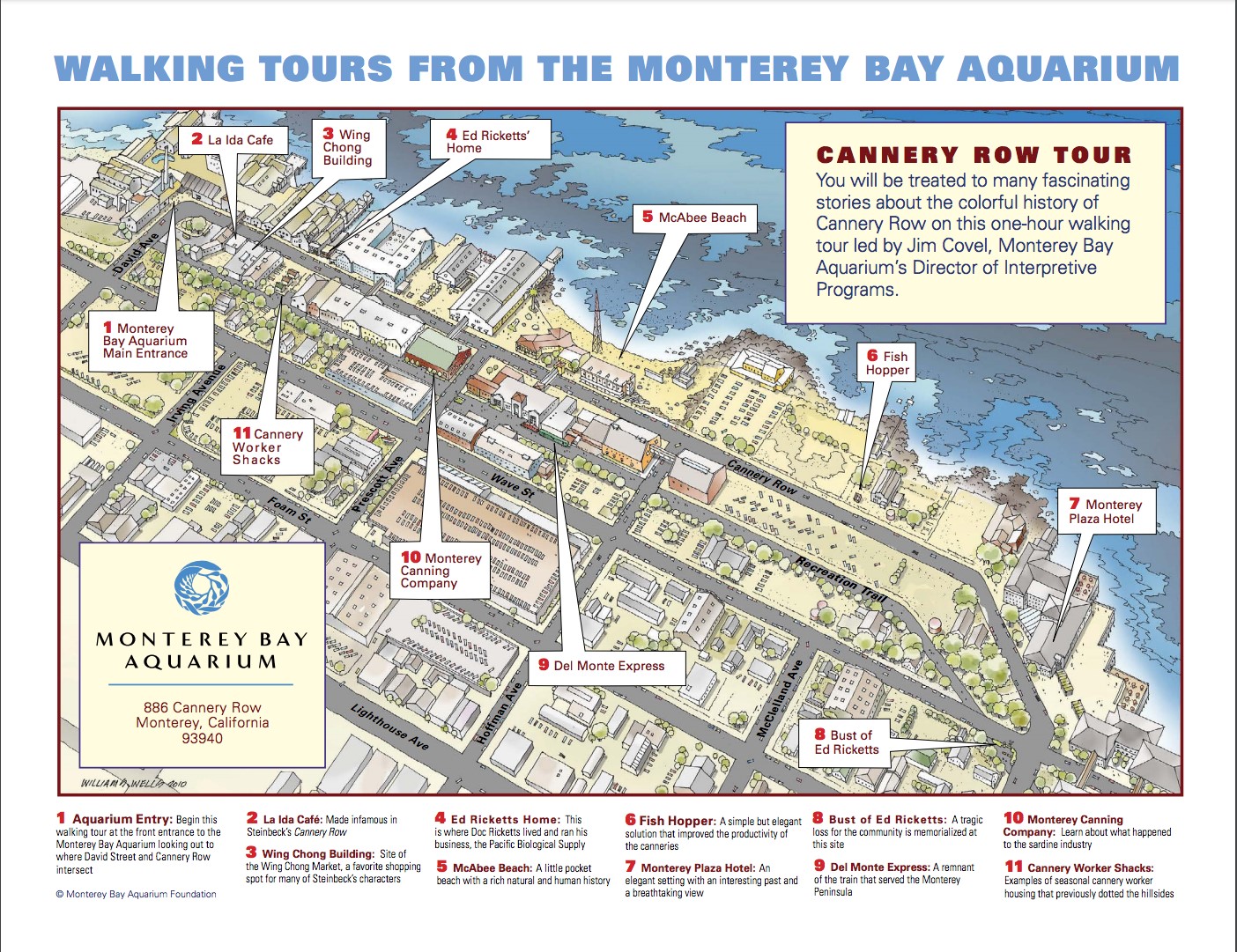Activity: Exploring Scenic and Historical Monterey
Setting:
This activity might be helpful for any short-term program features Content-based Instruction (CBI), such as:
- Diplomats working for Taiwanese Ministry of Foreign Affairs
- Translators and interpreters working for The Central Compilation and Translation Bureau of People’s Republic of China
- Accent reduction and improvement class
Level:
Intermediate to Advanced English learners with various first languages (L1s)
Rationale:
This activity will be using printable and downloadable resources on the website https://www.montereybayaquarium.org/visit/monterey-area/audio-walking-tours. Monterey Bay Aquarium created this website to provide a free guide to two walking tours in Monterey and Cannery Row, both starting outside the Aquarium. A printable map in PDF format marked with six highlights of the Coastal Recreation Trail and the other map marked with eleven highlights of the famed Cannery Row, which is vividly presented in John Steinbeck’s novel of the same name and has attracted readers and travelers’ attention all over the world. There are also mp3 files introducing each scenic spot marked on the maps available for downloading. The purpose of this activity is to provide intermediate to advanced English learners an opportunity to explore Monterey and Cannery Row while studying at Middlebury Institute of International Studies and build connections with the local community.
Procedures:
Before class
Teacher requests students to write a short reflection on the Note App or record their reflections on the Voice Memo App on their phones about their existing knowledge of Monterey and Cannery Row and be ready to share in class on the following day. Students are allowed to do research if needed. Students should also do some research about how to download a mp3 file to their phones or to iTunes on their iPhones if they have not known how to do it.
In class (1ST class)
- Think-Pair-Share: students share their reflections with each other in pairs and compile a blog post on the class website. They are welcome to post their reflections in audio format, too.
- Teacher introduces the walking tour website and asks students to explore its content on their own for ten minutes. Students then will compile a collaborative vocabulary list contains place names on the two maps, such as: Monterey Bay Aquarium, McAbee Beach, Bust of Ed Ricketts, etc. Considering learners’ English proficiency level in general, there should not be many unfamiliar words, but more like words that are specifically used in this local community may cause confusion. Students are encouraged to mark those words on the maps and explore those place during the field trip.
- The teacher announces the filed trip and the task: students will be divided into two teams, team Coastal Trail and team Cannery Row. They will explore the two places using the audio guide and maps. (Reading the map from their phones may cause confusion because of the small font, so learners can print out the maps and take them to the field trip). Learners are requested to pay attention to details in the audio files and write down key points, which could be something intrigues their thinking or something they have questions about. While exploring in one of the two places, pick one highlighted spot of the trip and be ready to recreate an original introduction of this spot. The presentation may include written materials, pictures, audio recordings, interviews with staff at different places and residents, etc. The target audience of this task could be students’ family members or friends who will either visit them in Monterey or live in their home country who are curious about their current life.
Homework
When students go back home after the one-hour field trip, students should organize all materials they have collected and create an audio recording/video recording, which introduces one scenic spot they picked from the field trip. The introduction can be the translation of the original audio to students’ L1, or paraphrasing in English. Students are also encouraged to report their reflections on this task, field trip, and the learning experience in general and incorporate these content into the audio/video.
In class (2nd class)
One student from team Monterey will be paired up with another from team Cannery Row, and so as the rest of the class. Students will be working in pairs to share their audios/videos and their reflections and make necessary changes based on their peer’s feedback. Before the class ends, they should upload their audios or videos to the course blog or website. The teacher will give each student feedback on the creation of audio/video artifacts, accuracy, and fluency of their language production. The final product will be a collaborative class blog/website that can be shared with students’ friends and families.






